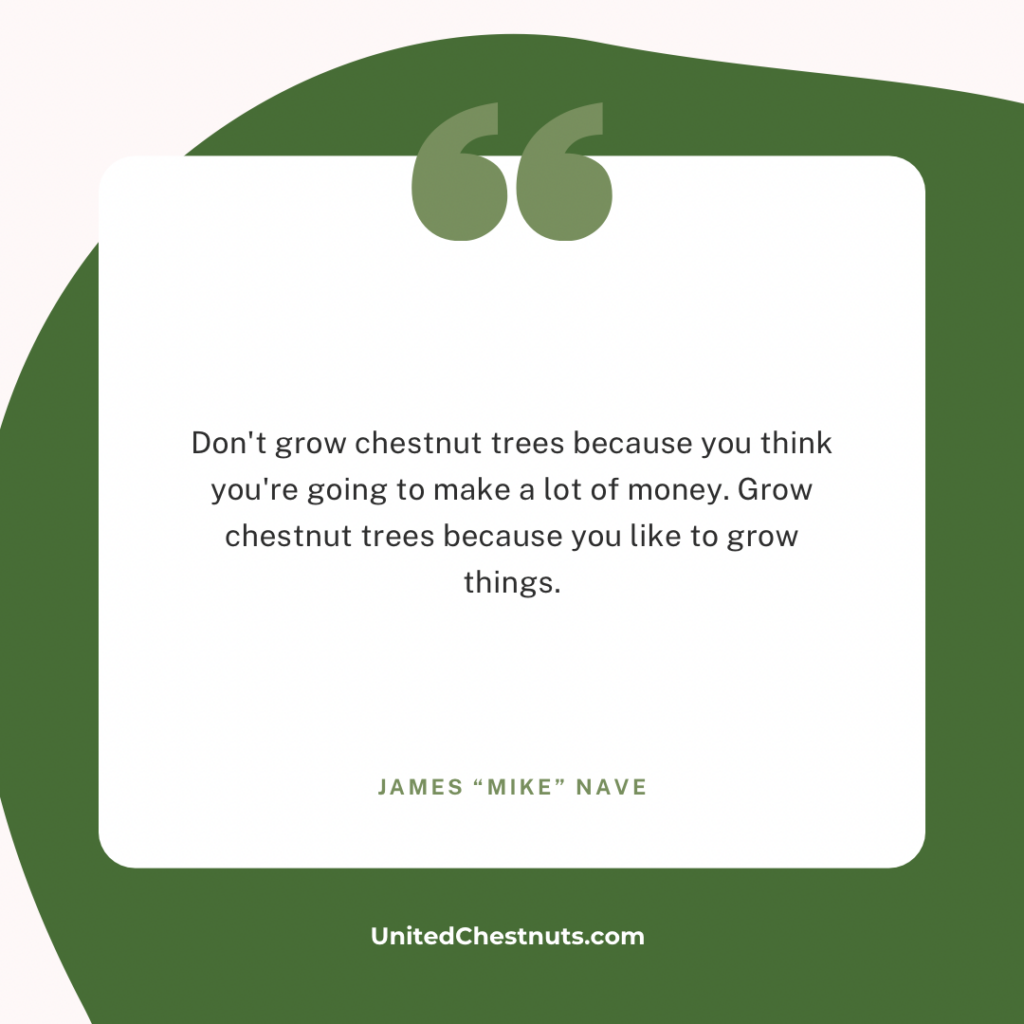
Navigating The Chestnut Landscape
Jame Nave joins the Branching Out podcast with exciting insights into the world of chestnuts.
In the latest episode of the Branching Out podcast, I had the pleasure of hosting James “Mike” Nave, an esteemed guest with decades of experience in the intricate world of chestnut cultivation. Our conversation unraveled the layers of knowledge, from soil intricacies to the nuances between East Coast and West Coast chestnut growing. Here’s a glimpse into the insightful dialogue we shared.
Soil as the Foundation
Our conversation kicked off with the foundational importance of soil in chestnut cultivation. Mike stressed the need for growers to comprehend their soil composition, drainage, and pH levels. “You have to know what kind of soil you’ve got and whether it’s going to drain well, have permeability, and have the right pH,” he highlighted, setting the stage for a deep dive into the intricacies of chestnut tree cultivation.
We discuss checking soil composition. Here is a recommended site.
Chestnut Tree Intricacies
We navigated through the complexities of various chestnut tree types, from Chinese to Sativa and hybrids. Mike provided invaluable insights into the challenges of grafting Chinese trees, showcasing the resilience and vigor of European Sativa trees.
East Coast vs. West Coast Dynamics
Our conversation took an intriguing turn as we explored the unique dynamics between East Coast and West Coast chestnut cultivation. On the West Coast, where blight isn’t a concern, there’s a prime opportunity to cultivate Sativa trees, celebrated for their larger nuts and high productivity. Mike encouraged West Coast growers to leverage this advantage, emphasizing the significant differences between the two coasts.
Hybridization for Future Growth
Delving into Mike’s current endeavors in Missouri, we discussed his efforts to keep Sativa trees alive for breeding purposes. The focus was on creating hybrids between Sativa and Chinese trees, a fascinating journey into the future possibilities of chestnut cultivation. “I’ve been able to get 20-30, 40 seed nuts that are hybrids between Sativa and Chinese,” he revealed.

James Facebook Group – Consider Joining
A Passion-Driven Approach
Concluding our conversation, Mike shared a refreshing perspective, advising chestnut growers to approach the venture with genuine passion. “Don’t grow chestnut trees because you think you’re going to make a lot of money. Grow chestnut trees because you like to grow things,” he emphasized, underlining the joy and fulfillment that comes from cultivating chestnuts.
As we wrap up this enlightening episode with James, I encourage you to delve deeper into the world of chestnut cultivation by subscribing to the Branching Out podcast. Uncover more gems of knowledge and fascinating conversations with experts in the field. You can find us on Spotify, Audible, iHeartRadio, and YouTube.
Don’t miss out on future episodes that promise to unravel the complexities, stories, and passions that make tree cultivation an art and science worth exploring. Subscribe today and join our growing community of tree enthusiasts on a journey of discovery.
____________________________________
Melanie mentions James’ Facebook Group description, and it is as follows:
This group is for discussing the Castanea family of nut trees. The emphasis here is on discussing chestnuts as an agricultural commodity, a food crop, for temperate regions. The United States is one of the few nations in the world that can grow chestnuts, yet doesn’t have a significant chestnut industry, while many of those nations that do have developed chestnut industries are facing challenges from chestnut blight, gall wasp, root rot (phytophthora), or other problems. Information and terms you should know and understand before you join this group: This group is a group devoted to growing chestnut trees for the production of quality nuts for human consumption. This is not a group to join simply because you have a few unanswered questions about chestnut trees.
This group does not focus on growing trees for wildlife or for forest restoration. If your primary interest is wildlife, you can probably learn a few things here, but wildlife is not the focus of this group.
This group does not focus on growing the American chestnut tree, Castanea dentata. If your primary interest is Castanea dentata, you may learn a few things here, but C. dentata is not the focus of this group.
Terms you should know BEFORE joining this group-Cultivar – sometimes called ‘variety’ but ‘cultivar’ is the correct terminology.
Seedlings of cultivars are not the same as cultivars. You should understand the difference before joining this group. Chestnut seedlings have two parents, just like humans. They have a father and a mother so a seedling will NEVER be exactly like either parent.
Burs are the spiny cases that hold maturing nuts on chestnut trees. The word is spelled ‘bur’. It is not spelled ‘burr’.
If your primary interest is restoring the American chestnut, you should look into these Facebook groups that focus on Castanea dentata – the American chestnut: American Chestnut Research and Restoration Project –
https://www.facebook.com/groups/esfchestnut/The American Chestnut Foundation –https://www.facebook.com/americanchestnut/https://www.facebook.com/americanchestnutgroup/https://www.facebook.com/PATACF.org /https://www.facebook.com/IndianaChestnut/ https://www.facebook.com/gatacf/?ref=br_rshttps://www.facebook.com/ CanadianChestnutCouncil https://www.facebook.com/groups/1555583611238696 or check out this non-Facebook group -American Chestnut Cooperators Foundation https://www.accf-online.org
Chestnut Naming:
Castanea mollissima
Castanea dentata
Castanea sativa
Castanea crenata
Castanea pumila
Castanea ozarkensis
Castanea alabamensis
Castanea henryi
Castanea seguinii
Châtaigne
Castagna
Kestane
Kastanje
Gaztaina
Castanha
Castaña
밤나무
板栗
栗
κάστανο
ΚΑΣΤΑΝΕΑ
Kάσταν
Κάστανο
Kastanie
Каштан
Gaštan